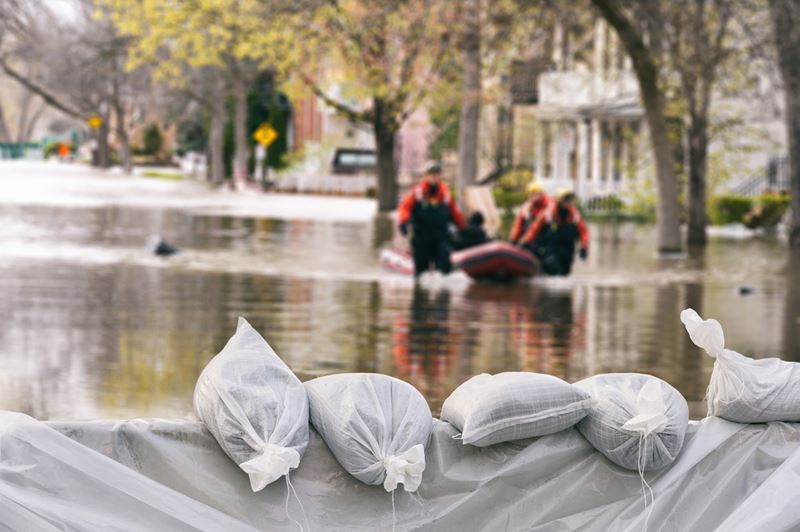Top 3 climate change risks your business should prepare for
Top 3 climate change risks your business should prepare for
From unprecedented wildfires to record-setting hurricanes, the impacts of climate change are front and center today. While the heat is on governments to tackle what the United Nations calls “the defining issue of our time,” G7 leaders are failing to meet climate change objectives.
Research from the Universal Ecological Fund found that most participating nations aren’t hitting their 2030 climate goals.1 The Fund’s “The Truth Behind the Climate Pledges” report examines carbon-emission reduction pledges made by 184 countries under the Paris Agreement. Nearly 75% of the commitments to reduce emissions between 2020 and 2030 are inadequate to slow climate change, and some of the world’s largest emitters will continue to increase emissions, according to the report.
That paints a pretty bleak picture for the health of the planet and its inhabitants. It paints a bleak picture for the business world as well. In the World Economic Forum’s “Global Risks Report 2020,” the top five global risks are all environmental. 2 Those related to climate change include extreme weather events with major damage to property, infrastructure and loss of human life, and failure of climate-change mitigation and adaptation by government and businesses.
All of this points to the importance of businesses taking steps to reduce their risks as they face the headwinds of climate change. While the issues vary from company to company and sector to sector, there are three main risks that all businesses should be preparing for:
1. Transition Risks
In the fight against climate change, many companies are exposed to transition risks. These arise from the policy, legal, technology and market changes required to transition to “net zero” greenhouse gas (GHG) emissions, which means removing as much carbon from the atmosphere as is emitted. 3 As Deloitte notes, these risks can lead to increased business costs, undermine the viability of existing products or services, or affect asset values. 4
To mitigate transition risks, establishing risk assessments and targets is a good starting point. Taking action in the transition to net-zero requires businesses to look for new opportunities and ways to innovate. According to the Task Force on Climate-Related Financial Disclosures, opportunities include developing new products that are less carbon intensive; reducing operating costs by improving efficiency across production and distribution processes; and building resilience along the supply chain, for example, by shifting from fossil fuels towards renewable energy. 5 Businesses could also consider sourcing/buying local to help reduce the carbon footprint.
2. Physical Risks
Physical risks of climate change include direct damage to assets, such as buildings and infrastructure damaged by flooding and forest fires, and indirect impacts such as disruption to supply chain and food systems. There are physical risks related to human health as well: hazards like heat stress could affect the ability of people to work outdoors, or in extreme cases, put human lives at risk. 6,7
While their effects are wide-ranging, physical risks receive less attention from businesses than carbon reduction. According to CDP, a non-profit organization that runs the global disclosure system of environmental impacts, companies reported double the number of transitional risks than physical risks, indicating that the physical side of climate change is still underestimated. 8,9 Perhaps this is partly due to their perception that they’re protected from physical risks through their commercial insurance policy. Business owners needs to consult with their broker to confirm what coverage they have in place, and what may or may not be available, to protect their business from certain physical risks.
McKinsey Global Institute notes that while companies and communities have been adapting to reduce climate risk, the pace and scale of adaptation need to significantly increase to manage rising levels of physical climate risk. Adaptation is likely to entail rising costs and tough choices that may include whether to invest in hardening (physically improve or building new infrastructure to make it less susceptible to damage) or relocate people and assets.10
3. Liability Risks
The third area of climate-change risk is the potential liability for emitting greenhouse gases. An increasing number of legal cases have been brought against fossil fuel companies and utilities in recent years, holding them accountable for the damaging effects of climate change.11 In fact, recent estimates suggest there’s been nearly 1,000 climate change related class-action suits filed in 25 countries. Victoria, B.C., for example, became the first municipality in Canada to endorse a class-action lawsuit against oil and gas producers for climate-related harms last year.12
A report from global law firm Clyde & Co notes that in view of the wide range of possible liability exposure, there is no simple or one-size-fits-all solution for companies that want to limit their exposure to litigation. However, there are a few points to keep in mind: companies that understand their transition risks and physical risks will be better placed to understand their liability exposures; liability risk will differ from jurisdiction to jurisdiction; and as science becomes more certain and knowledge grows around climate change effects, best practices will develop. 13
Today’s environmental issues are not going away. Companies need to take responsibility for their actions and reduce their negative environmental impact. Now is also the time to start being proactive about climate-related risk mitigation and talking to your broker about how to protect your business.
Sources
1 “Most countries aren’t hitting 2030 climate goals, and everyone will pay the price,” National Geographic, Nov. 5 2019.
2 “The Global Risks Report 2020,” World Economic Forum, Jan. 15 2020.
3,5 “Recommendations of the Task Force on Climate-Related Financial Disclosures,” TCFD, Financial Stability Board, June 15 2017.
4,11 “Feeling the heat? Companies are under pressure on climate change and need to do more,” Dec. 12 2019.
6 Transition risk framework: Managing the impacts of the low carbon transition on infrastructure investments,” University of Cambridge Institute for Sustainability Leadership (CISL), 2019.
7,10 Climate risk and response: Physical hazards and socioeconomic impacts; McKinsey Global Institute, Jan. 16 2020.
8 “Global Climate Change Analysis 2018,” CDP, June 4, 2019
9 “Factoring climate risk infrastructure investment,” World Bank, Aug. 29 2019.
12 “Climate change litigation arrives in Canada,” Osler, Feb. 5 2019.
13 “New liability risks to businesses, directors and offices,” Clyde & Co, July 31 2019.


